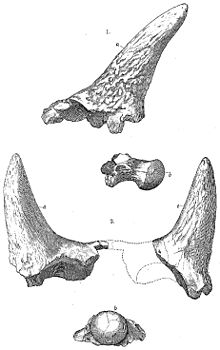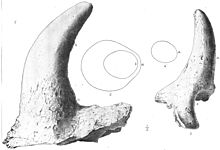- Ceratops
-
Ceratops
Temporal range: Late Cretaceous, 75 Ma
Illustration of the type specimen by Marsh Scientific classification 
Phylum: Chordata Class: Reptilia Superorder: Dinosauria Order: †Ornithischia Suborder: †Ceratopsia Family: †Ceratopsidae Subfamily: †Ceratopsinae
Marsh, 1888Genus: †Ceratops
Marsh, 1888Species: †C. montanus Binomial name Ceratops montanus
Marsh, 1888Synonyms - Proceratops montanus
(Marsh, 1888) Lull, 1906
Ceratops (meaning "horn face") is a dubious genus of ceratopsian dinosaur which lived during the Late Cretaceous. Its fossils have been found in Montana. Although poorly known, Ceratops is important in the history of dinosaurs, since it is the type species for which both Ceratopsia and Ceratopsidae are named. Unfortunately, the material is too poor to be confidently referred to better specimens, and Ceratops is considered a nomen dubium.
Contents
History
The first remains referred to Ceratops (an occipital condyle and a pair of horn cores) were found by John Bell Hatcher (1861–1904) in the summer of 1888 in the uppermost Judith River Formation of Montana. O. C. Marsh originally believed the animal to be similar to Stegosaurus, but with two horns on its head.
In 1995, Trexler and Sweeney noted that complete material from a bonebed that had been found in Montana could enable Ceratops to be reexamined. The site, known as the Mansfield Bonebed, belongs to the same stratigraphic level as the one the yielded the original Ceratops remains. It had initially been interpreted as containing Styracosaurus, but what earlier authors considered the frill spikes of Styracosaurus turned out to be chasmosaurine orbital horns. Trexler and Sweeney pointed out that these horns closely resembled those of Ceratops, and could allow the genus to be rescued as a valid name.[1] The ceratopsids in the bonebed were later referred to the genus Albertaceratops, and later re-classified in their own genus, Medusaceratops.[2]
In 2005, remarkably well preserved cranial and post cranial elements of a Judithian ceratopsian were discovered in Fergus County, Montana. Examination suggests close affinity with C. montanus. The locality has been determined to be on or in close proximity to the stratigraphic layer of C. montanus, and not too many miles away. The fossils have since been meticulously prepared, studied and evaluated. A team of writers is currently (Q1, 2011) in the process of preparing for publication. This specimen may or may not be referred to C. montanus; debate on the merits of referring to a nomen dubium versus a new species designation continue.[citation needed]
Classification
Ceratops belonged to the Ceratopsia (the name is Ancient Greek for "horned face"), a group of herbivorous dinosaurs with parrot-like beaks which thrived in North America and Asia during the Cretaceous Period, which ended roughly 65 million years ago.
In 1999, Penkalski and Dodson concluded Ceratops is a nomen dubium because the material is too meager. They add that Avaceratops appears closely related and may even be a juvenile Ceratops but there is not enough material to prove it.[3]
Species
Type:
- Ceratops montanus Marsh 1888 (USNM 2411)
Others:
- C. (Bison) alticornis (Marsh 1887/1889). This was the famous pair of horn cores that were originally thought by Marsh to be from a giant bison. Marsh realized his error in 1889 and referred the horns to his Ceratops. Today they are recognized as the first Triceratops remains found and are, to date, the southernmost known Triceratops fossils. Even as Triceratops, it also is a nomen dubium.
- C. (Chasmosaurus) belli (Lambe 1902/Hatcher vide Stanton & Hatcher 1905)
- C. (Eoceratops) canadensis (Lambe 1902/Hatcher vide Stanton & Hatcher 1905)
- C. (Triceratops) horridus (Marsh 1889). This was the first intact ceratopsian skull discovered and led Marsh to realize the significance of the other specimens. As with the aforementioned species, it too is currently recognized as Triceratops.
- C. paucidens (Marsh 1889/1890); nomem dubium included with Lambeosaurus lambei
- C. (Chasmosaurus) recurvicornis (Cope 1890/Hatcher vide Stanton & Hatcher 1905)
Diet
Ceratops, like all Ceratopsians, was a herbivore.
References
- ^ Trexler, D. and Sweeney, F.G. (1995). "Preliminary work on a recently discovered ceratopsian (Dinosauria: Ceratopsidae) bonebed from the Judith River Formation of Montana suggests the remains are of Ceratops montanus Marsh." Journal of Vertebrate Paleontology, 15(3, Suppl.): 57A.
- ^ Ryan, Michael J.; Russell, Anthony P., and Hartman, Scott. (2010). "A New Chasmosaurine Ceratopsid from the Judith River Formation, Montana", In: Michael J. Ryan, Brenda J. Chinnery-Allgeier, and David A. Eberth (eds), New Perspectives on Horned Dinosaurs: The Royal Tyrrell Museum Ceratopsian Symposium, Indiana University Press, 656 pp. ISBN 0253353580.
- ^ Penkalski, P & Dodson, P (1999). "The morphology and systematics of Avaceratops, a primitive horned dinosaur from the Judith River Formation (Late Campanian) of Montana, with the description of a second skull.". Journal of Vertebrate Paleontology 19 (4): 692–711. doi:10.1080/02724634.1999.10011182.
External links
Categories:- Ceratopsids
- Cretaceous dinosaurs
- Dinosaurs of North America
- Nomina dubia
- Proceratops montanus
Wikimedia Foundation. 2010.

